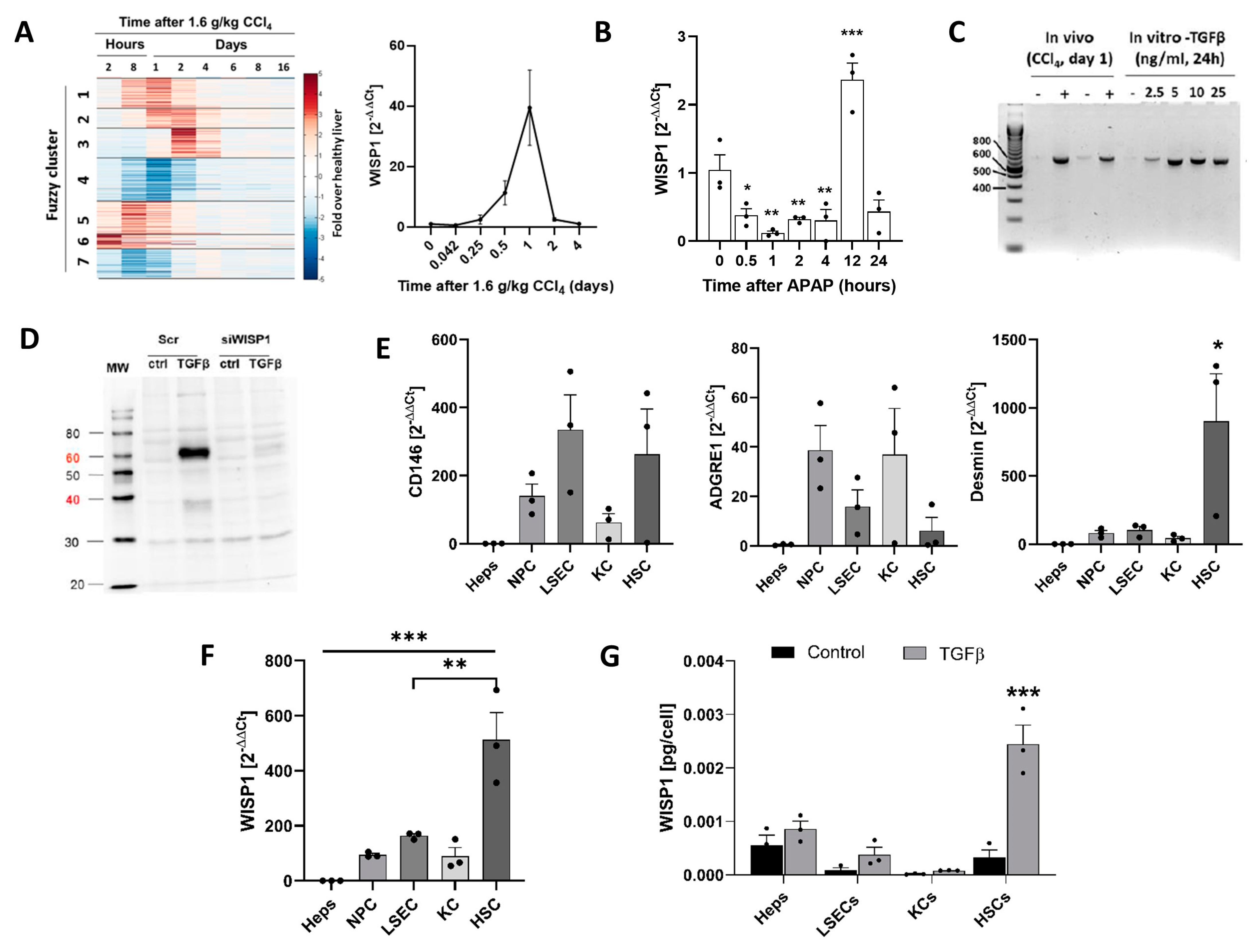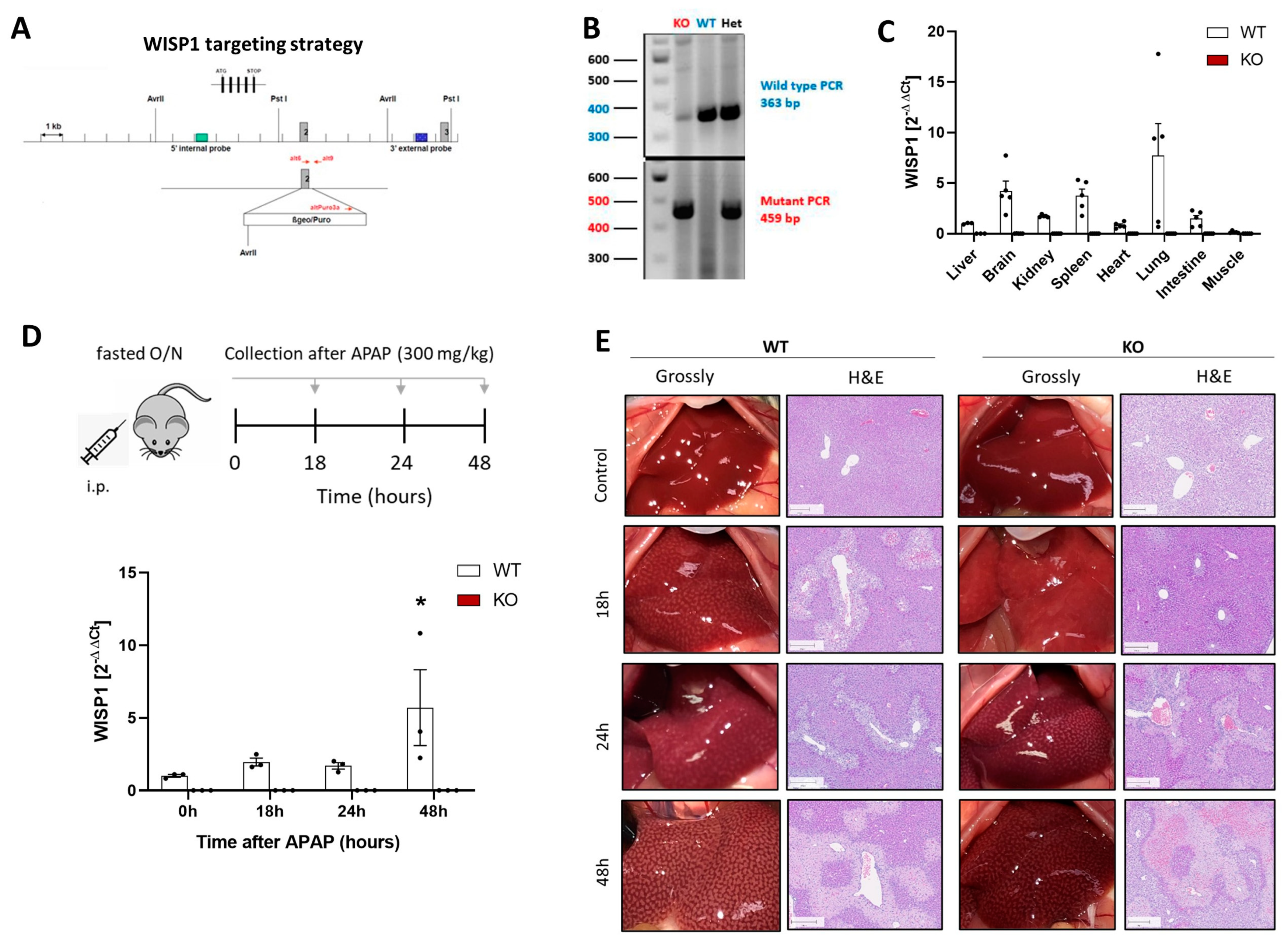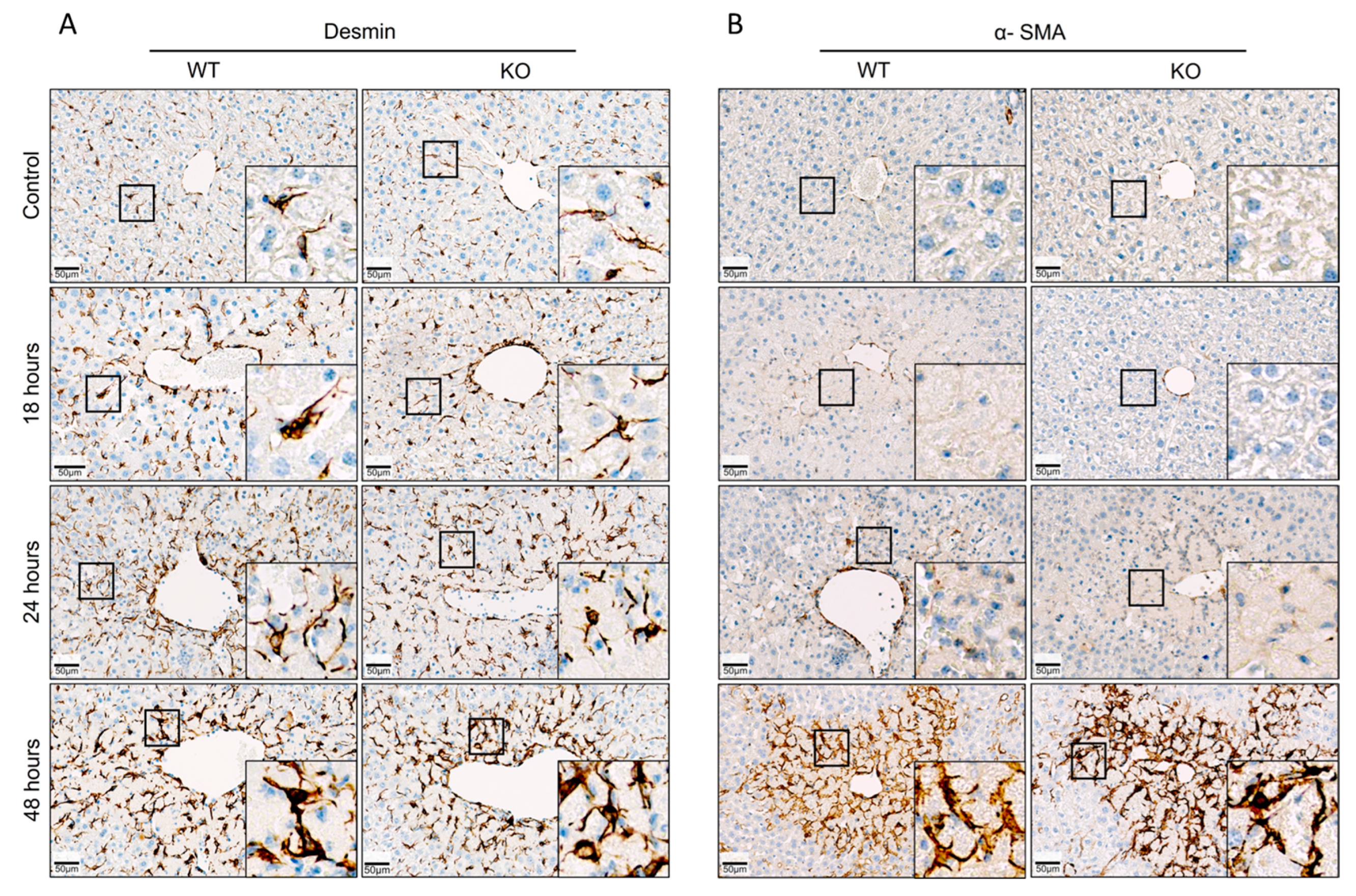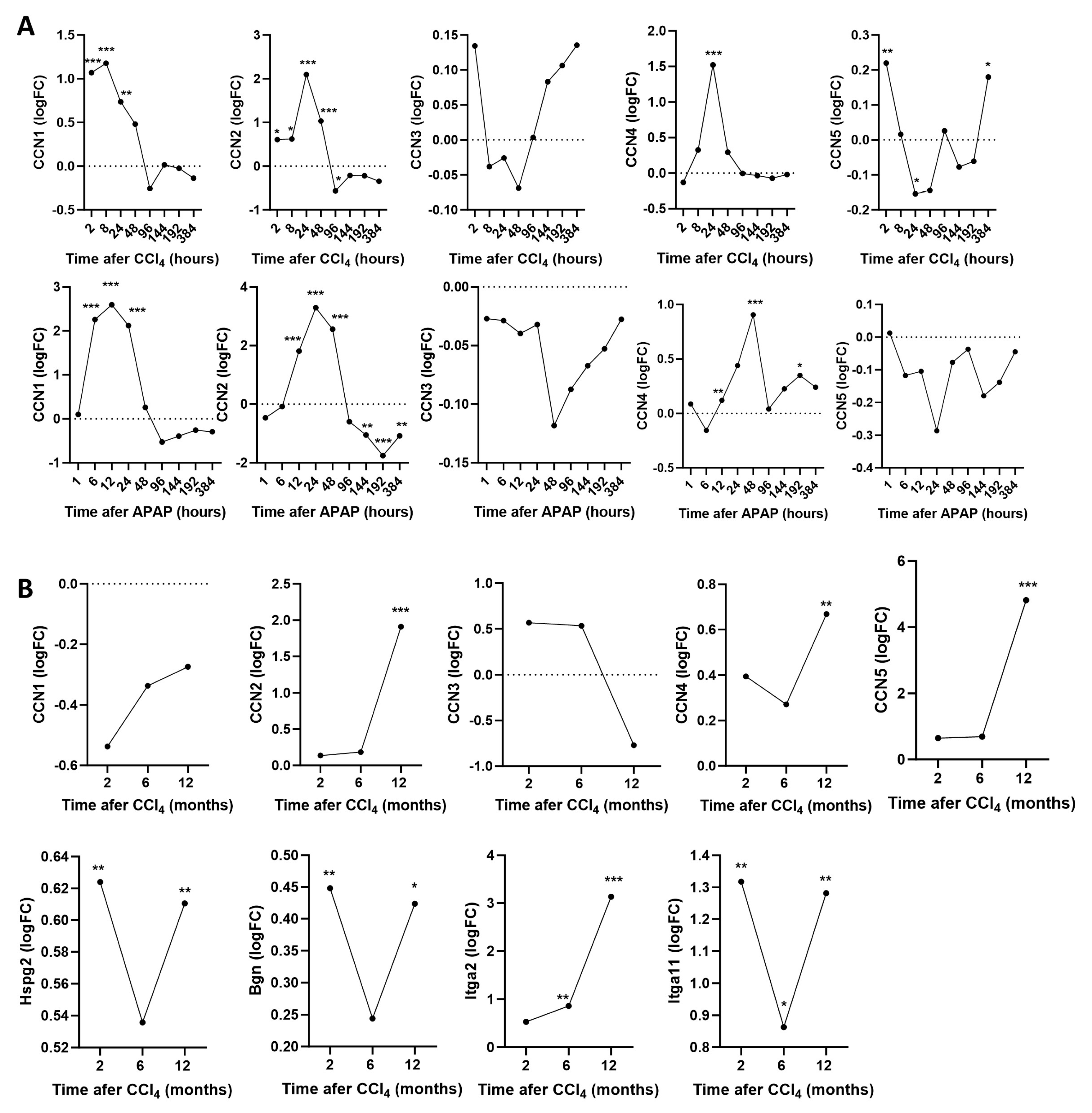Role of WISP1 in Stellate Cell Migration and Liver Fibrosis
Abstract
:1. Introduction
2. Materials and Methods
2.1. Animal Experiments
2.2. Cell Isolation and Cell Culture
2.3. Migration Assay
2.4. Collagen and WISP1 Protein Quantification
2.5. Histopathology and Immunohistochemistry
2.6. Image Analysis
2.7. Analysis of Blood Biomarkers of Liver Damage
2.8. RNA Isolation, cDNA Synthesis and Real-Time Quantitative PCR
2.9. Western Blot
2.10. Statistical Analysis
3. Results
3.1. WISP1 Is Secreted by Hepatocytes and Stellate Cells in Response to Acute Liver Damage and TGFβ
3.2. WISP1 Stimulates the Migration of Stellate Cells through Collagen In Vitro
3.3. Acute and Chronic Liver Damage in WISP1 Knockout Mice
4. Discussion
5. Conclusions
Supplementary Materials
Author Contributions
Funding
Institutional Review Board Statement
Informed Consent Statement
Data Availability Statement
Acknowledgments
Conflicts of Interest
Abbreviations
| ALT | alanine transaminase |
| AST | aspartate transaminase |
| ALP | alkaline phosphatase |
| i.p. | intraperitoneal |
| Heps | hepatocytes |
| NPC | non-parenchymal cells |
| KCs | Kupffer cells |
| LSECs | liver sinusoidal endothelial cells |
| HSCs | hepatic stellate cells |
| TGFβ | tumor growth factor beta |
References
- Frantz, C.; Stewart, K.M.; Weaver, V.M. The extracellular matrix at a glance. J. Cell Sci. 2010, 123, 4195–4200. [Google Scholar] [CrossRef] [PubMed]
- Theocharis, A.D.; Manou, D.; Karamanos, N.K. The extracellular matrix as a multitasking player in disease. FEBS J. 2019, 286, 2830–2869. [Google Scholar] [CrossRef] [PubMed]
- Piperigkou, Z.; Götte, M.; Theocharis, A.D.; Karamanos, N.K. Insights into the key roles of epigenetics in matrix macromolecules-associated wound healing. Adv. Drug Deliv. Rev. 2018, 129, 16–36. [Google Scholar] [CrossRef] [PubMed]
- Karamanos, N.K.; Theocharis, A.D.; Neill, T.; Iozzo, R.V. Matrix modeling and remodeling: A biological interplay regulating tissue homeostasis and diseases. Matrix Biol. 2018, 75-76, 1–11. [Google Scholar] [CrossRef]
- Ikeda, K.; Wakahara, T.; Wang, Y.Q.; Kadoya, H.; Kawada, N.; Kaneda, K. In Vitro Migratory potential of rat quiescent hepatic stellate cells and its augmentation by cell activation. Hepatology 1999, 29, 1760–1767. [Google Scholar] [CrossRef] [PubMed]
- Cenacchi, G.; Ballardini, G.; Giorgi, L.B.; Busachi, C.A.; Rosso, M.; Bianchi, F.B.; Biagini, G.; Laschi, R. Relationship between connective tissue cells and fibronectin in a sequential model of experimental hepatic fibrosis. Virchows Arch. B Cell Pathol. Incl. Mol. Pathol. 1983, 43, 75–84. [Google Scholar] [CrossRef]
- Ballardini, G.; Degli Esposti, S.; Bianchi, F.B.; De Giorgi, L.B.; Faccani, A.; Biolchini, L.; Busachi, C.A.; Pisi, E. Correlation between Ito cells and fibrogenesis in an experimental model of hepatic fibrosis. A sequential stereological study. Liver Int. 1983, 3, 58–63. [Google Scholar] [CrossRef]
- Takahara, T.; Furui, K.; Yata, Y.; Jin, B.; Zhang, L.P.; Nambu, S.; Sato, H.; Seiki, M.; Watanabe, A. Dual expression of matrix metalloproteinase-2 and membrane-type 1-matrix metalloproteinase in fibrotic human livers. Hepatology 1997, 26, 1521–1529. [Google Scholar] [CrossRef]
- Yang, C.; Zeisberg, M.; Mosterman, B.; Sudhakar, A.; Yerramalla, U.; Holthaus, K.; Xu, L.; Eng, F.; Afdhal, N.; Kalluri, R. Liver fibrosis: Insights into migration of hepatic stellate cells in response to extracellular matrix and growth factors. Gastroenterology 2003, 124, 147–159. [Google Scholar] [CrossRef]
- Jia, H.; Janjanam, J.; Wu, S.C.; Wang, R.; Pano, G.; Celestine, M.; Martinot, O.; Breeze-Jones, H.; Clayton, G.; Garcin, C.; et al. The tumor cell-secreted matricellular protein WISP 1 drives pro-metastatic collagen linearization. EMBO J. 2019, 38, e101302. [Google Scholar] [CrossRef]
- Maiese, K. WISP1: Clinical Insights for a Proliferative and Restorative Member of the CCN Family. Curr. Neurovascular Res. 2014, 11, 378–389. [Google Scholar] [CrossRef]
- Li, X.; Chen, Y.; Ye, W.; Tao, X.; Zhu, J.; Wu, S.; Lou, L. Experimental research Blockade of CCN4 attenuates CCl 4 -induced liver fibrosis. Arch. Med. Sci. 2015, 3, 647–653. [Google Scholar] [CrossRef] [PubMed]
- Jung, T.W.; Kang, C.; Goh, J.; Chae, S.I.; Kim, H.; Lee, T.J.; El-Aty, A.A.; Jeong, J.H. WISP1 promotes non-alcoholic fatty liver disease and skeletal muscle insulin resistance via TLR4/JNK signaling. J. Cell. Physiol. 2018, 233, 6077–6087. [Google Scholar] [CrossRef] [PubMed]
- Chen, C.-T.; Lee, H.-L.; Chiou, H.-L.; Chou, C.-H.; Wang, P.-H.; Yang, S.-F.; Chou, Y.-E. Impacts of WNT1-inducible signaling pathway protein 1 polymorphism on hepatocellular carcinoma development. PLoS ONE 2018, 13, e0198967. [Google Scholar] [CrossRef]
- Ghallab, A.; Hassan, R.; Hofmann, U.; Friebel, A.; Hobloss, Z.; Brackhagen, L.; Begher-Tibbe, B.; Myllys, M.; Reinders, J.; Overbeck, N.; et al. Interruption of bile acid uptake by hepatocytes after acetaminophen overdose ameliorates hepatotoxicity. J. Hepatol. 2022, 77, 71–83. [Google Scholar] [CrossRef]
- Ghallab, A.; González, D.; Strängberg, E.; Hofmann, U.; Myllys, M.; Hassan, R.; Hobloss, Z.; Brackhagen, L.; Begher-Tibbe, B.; Duda, J.C.; et al. Inhibition of the renal apical sodium dependent bile acid transporter prevents cholemic nephropathy in mice with obstructive cholestasis. J. Hepatol. 2024, 80, 268–281. [Google Scholar] [CrossRef]
- Maschmeyer, P.; Flach, M.; Winau, F. Seven Steps to Stellate Cells. J. Vis. Exp. 2011, e2710. [Google Scholar] [CrossRef]
- Elvevold, K.; Kyrrestad, I.; Smedsrød, B. Protocol for Isolation and Culture of Mouse Hepatocytes (HCs), Kupffer Cells (KCs), and Liver Sinusoidal Endothelial Cells (LSECs) in Analyses of Hepatic Drug Distribution. In Antisense RNA Design, Delivery, and Analysis; Arechavala-Gomeza, V., Garanto, A., Eds.; Methods in Molecular Biology; Springer: New York, NY, USA, 2022; pp. 385–402. ISBN 978-1-07-162010-6. [Google Scholar]
- Bankhead, P.; Loughrey, M.B.; Fernández, J.A.; Dombrowski, Y.; McArt, D.G.; Dunne, P.D.; McQuaid, S.; Gray, R.T.; Murray, L.J.; Coleman, H.G.; et al. QuPath: Open source software for digital pathology image analysis. Sci. Rep. 2017, 7, 16878. [Google Scholar] [CrossRef]
- van der Walt, S.; Schönberger, J.L.; Nunez-Iglesias, J.D.; Boulogne, F.; Warner, J.; Yager, N.; Gouillart, E.; Yu, T. scikit-image: Image processing in Python. PeerJ 2014, 2, e453. [Google Scholar] [CrossRef]
- Lee, T.; Kashyap, R.; Chu, C. Building Skeleton Models via 3-D Medial Surface Axis Thinning Algorithms. CVGIP: Graph. Model. Image Process. 1994, 56, 462–478. [Google Scholar] [CrossRef]
- Campos, G.; Schmidt-Heck, W.; De Smedt, J.; Widera, A.; Ghallab, A.; Pütter, L.; González, D.; Edlund, K.; Cadenas, C.; Marchan, R.; et al. Inflammation-associated suppression of metabolic gene networks in acute and chronic liver disease. Arch. Toxicol. 2020, 94, 205–217. [Google Scholar] [CrossRef]
- Ghallab, A.; Myllys, M.; Friebel, A.; Duda, J.; Edlund, K.; Halilbasic, E.; Vucur, M.; Hobloss, Z.; Brackhagen, L.; Begher-Tibbe, B.; et al. Spatio-Temporal Multiscale Analysis of Western Diet-Fed Mice Reveals a Translationally Relevant Sequence of Events during NAFLD Progression. Cells 2021, 10, 2516. [Google Scholar] [CrossRef] [PubMed]
- Holland, C.H.; Flores, R.O.R.; Myllys, M.; Hassan, R.; Edlund, K.; Hofmann, U.; Marchan, R.; Cadenas, C.; Reinders, J.; Hoehme, S.; et al. Transcriptomic Cross-Species Analysis of Chronic Liver Disease Reveals Consistent Regulation Between Humans and Mice. Hepatol. Commun. 2021, 6, 161–177. [Google Scholar] [CrossRef] [PubMed]
- Janjanam, J.; Pano, G.; Wang, R.; Minden-Birkenmaier, B.A.; Breeze-Jones, H.; Baker, E.; Garcin, C.; Clayton, G.; Shirinifard, A.; Zaske, A.M.; et al. Matricellular Protein WISP2 Is an Endogenous Inhibitor of Collagen Linearization and Cancer Metastasis. Cancer Res. 2021, 81, 5666–5677. [Google Scholar] [CrossRef]
- Wang, Q.-Y.; Feng, Y.-J.; Ji, R. High expression of WISP1 promotes metastasis and predicts poor prognosis in hepatocellular carcinoma. Eur. Rev. Med. Pharmacol. Sci. 2020, 24, 10445–10451. [Google Scholar] [CrossRef]
- Tanaka, S.; Sugimachi, K.; Kameyama, T.; Maehara, S.; Shirabe, K.; Shimada, M.; Wands, J.R.; Maehara, Y. Human WISP1v, a member of the CCN family, is associated with invasive cholangiocarcinoma. Hepatology 2003, 37, 1122–1129. [Google Scholar] [CrossRef]
- Singh, K.; Oladipupo, S.S. An overview of CCN4 (WISP1) role in human diseases. J. Transl. Med. 2024, 22, 1–24. [Google Scholar] [CrossRef]
- Singh, D.; Rai, V.; Agrawal, D.K. Regulation of Collagen I and Collagen III in Tissue Injury and Regeneration. Cardiol. Cardiovasc. Med. 2023, 07, 5–16. [Google Scholar] [CrossRef] [PubMed]
- Roche, P.; Czubryt, M. Transcriptional Control of Collagen I Gene Expression. Cardiovasc. Hematol. Disord. Targets 2014, 14, 107–120. [Google Scholar] [CrossRef]
- Miyauchi, A.; Noguchi, M.; Lei, X.-F.; Sakaki, M.; Kobayashi-Tanabe, M.; Haraguchi, S.; Miyazaki, A.; Kim-Kaneyama, J.-R. Knockdown of mechanosensitive adaptor Hic-5 ameliorates post-traumatic osteoarthritis in rats through repression of MMP-13. Sci. Rep. 2023, 13, 7446. [Google Scholar] [CrossRef]







Disclaimer/Publisher’s Note: The statements, opinions and data contained in all publications are solely those of the individual author(s) and contributor(s) and not of MDPI and/or the editor(s). MDPI and/or the editor(s) disclaim responsibility for any injury to people or property resulting from any ideas, methods, instructions or products referred to in the content. |
© 2024 by the authors. Licensee MDPI, Basel, Switzerland. This article is an open access article distributed under the terms and conditions of the Creative Commons Attribution (CC BY) license (https://creativecommons.org/licenses/by/4.0/).
Share and Cite
González, D.; Campos, G.; Pütter, L.; Friebel, A.; Holland, C.H.; Holländer, L.; Ghallab, A.; Hobloss, Z.; Myllys, M.; Hoehme, S.; et al. Role of WISP1 in Stellate Cell Migration and Liver Fibrosis. Cells 2024, 13, 1629. https://doi.org/10.3390/cells13191629
González D, Campos G, Pütter L, Friebel A, Holland CH, Holländer L, Ghallab A, Hobloss Z, Myllys M, Hoehme S, et al. Role of WISP1 in Stellate Cell Migration and Liver Fibrosis. Cells. 2024; 13(19):1629. https://doi.org/10.3390/cells13191629
Chicago/Turabian StyleGonzález, Daniela, Gisela Campos, Larissa Pütter, Adrian Friebel, Christian H. Holland, Leonhard Holländer, Ahmed Ghallab, Zaynab Hobloss, Maiju Myllys, Stefan Hoehme, and et al. 2024. "Role of WISP1 in Stellate Cell Migration and Liver Fibrosis" Cells 13, no. 19: 1629. https://doi.org/10.3390/cells13191629







